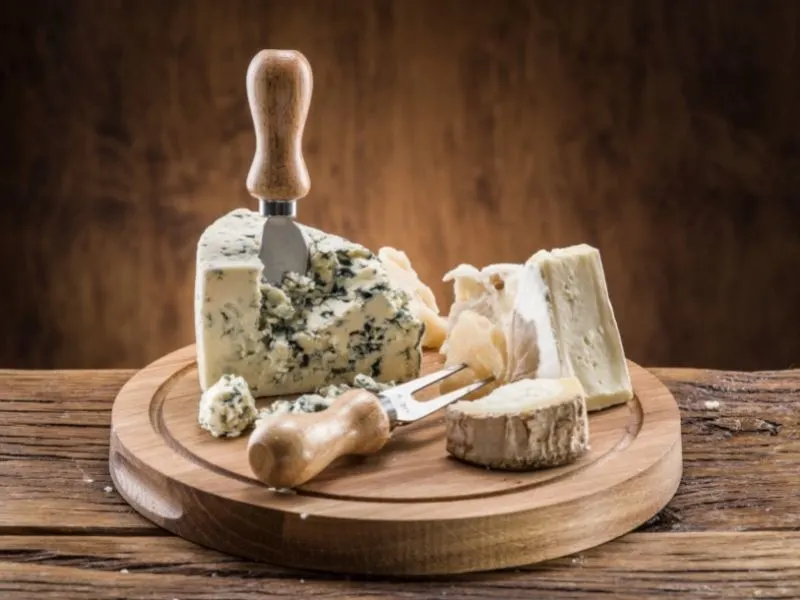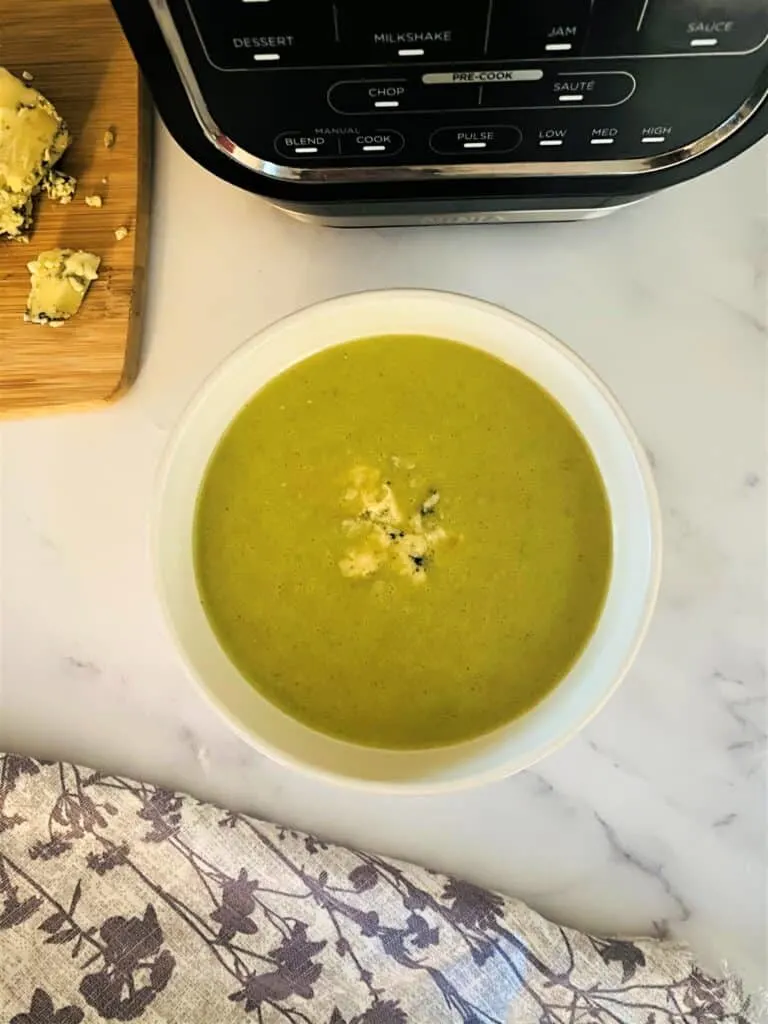Do you love blue cheese?
In this guide, we will explore the most popular different types of blue cheese that are available on the market.
We’ll discuss their flavour profiles, how they’re made, and where you can purchase them.
Whether you’re a blue cheese novice or an experienced connoisseur, this guide is for you!

What Is Blue Cheese?
Blue cheese is a type of cheese that gets its distinctive blue veining from the addition of mould. The mould spores are injected into the cheese during the manufacturing process, and as the cheese ages, the mould spreads throughout the body of the cheese.
While there are many different types of blue cheese, they can all be broadly classified into two main categories: vein-type cheeses and spreadable cheeses.

Vein-type cheeses, such as Gorgonzola and Roquefort, have a crumbly texture and well-defined veins of blue mould.
Spreadable cheeses, on the other hand, have a softer consistency and a more even distribution of mould throughout the body of the cheese. Some of the most popular spreadable blue cheeses include Danish Blue and Stilton.
Flavour Profile
Blue cheese has a strong, pungent flavour that can be quite polarizing. Some people love it, while others find it too intense.
The flavour of blue cheese is complex and multi-dimensional, with notes of earthiness, bitterness, saltiness, and sweetness.
How Blue Cheese Is Made
Blue cheese is made by adding mould spores to cow’s milk, sheep’s milk, or goat’s milk.
The mould spores will grow and spread throughout the cheese as it ages, causing it to take on a blue colouration.
Most blue cheeses are aged for at least two months, but some can be aged for up to two years.
Where to Buy Blue Cheese
Blue cheese is widely available at supermarkets and speciality cheese shops:
- Paxton & Whitfield – Britain’s leading cheesemonger for over 225 years, sourcing and maturing exceptional cheeses.
- The Courtyard Dairy
- The Fine Cheese Company
Here are the main popular types of blue cheese:
Stilton

Stilton is a cheese that has been made in England since the 18th century.
It is a hard, crumbly cheese with distinctive blue veining. The flavour of Stilton is both sharp and creamy, with a slightly nutty taste.
It is often used in salads, as a filling in sandwiches, or with some crackers, bread or biscuits.
Stilton is also known for its ability to melt well, making it a popular choice for use in sauces, gratins or for melting into soups.
When choosing a Stilton cheese, look for one that is firm to the touch and has an even distribution of blue veining. The cheese should also have a pleasant aroma. Avoid cheeses that are overly crumbly or have an unpleasant smell.
Stilton cheese can be stored in the fridge for up to two weeks.
Popular Stilton Recipes

- Broccoli and Stilton Soup (in a soup maker)
- Celery and Stilton Soup
- Broccoli and Stilton Quiche
- Beef and Stilton Pie
- Stilton Sauce
Gorgonzola

Gorgonzola cheese is a type of blue cheese that originated in Italy. It is made from cow’s milk and has a sharp, nutty and salty flavour.
The cheese is crumbly and has a creamy texture. It ranges in colour from white to pale yellow and has greenish-blue veins running through it.
Gorgonzola cheese is aged for two to three months and is typically used in salads, pasta dishes, and pizza. It can also be eaten on its own as a flavourful snack.
Gorgonzola is one of the world’s oldest cheeses, having been made since 879AD. According to the website Gorgonzola:
“Gorgonzola is a very ancient cheese. Some say Gorgonzola was first produced in the town of Gorgonzola, near Milan, in the year 879 AD. Some others say that it was first produced in Pasturo Nella Valsassina, a great cheese-making area for centuries, due to the presence of excellent natural caves where the average temperature is constantly between 6°C and 12°C.”
Popular Gorgonzola Recipes
- Penne with Gorgonzola Sauce
- Gorgonzola and Walnut Salad
- Pesto Gorgonzola Gnocchi
- Gorgonzola Pizza
Roquefort

Roquefort cheese is a sheep milk cheese from the south of France. It is dense and creamy, with an intense sharp flavour.
Roquefort cheese is typically aged for three to four months, during which time it develops a crumbly texture.
When shopping for Roquefort cheese, look for a brand that bears the Appellation d’Origine Contrôlée (AOC) label. This ensures that the cheese was made in the traditional French way, using only sheep’s milk and the Roquefort mould.
Popular Roquefort Recipes
- Roquefort and Bacon Salad
- Roquefort Tart
- Grilled Cheese with Roquefort
- Roquefort Dressing
Castello

Castello Creamy Blue cheese is a delicious, soft, and buttery cheese that is perfect for any occasion.
Made in Denmark with milk from grass-fed cows, this cheese has a delicate sharpness that is not overpowering.
The blue in the name comes from the blue mould that is used to ripen the cheese.
This cheese is perfect for spreading on crackers or bread, or for use in salads. It is also a great addition to any cheese platter.
Stichelton

Stichelton is a medium to strong English blue cheese that is known for its nutty flavour.
Stichelton is a raw milk traditional English blue cheese made on the Welbeck Estate in Nottinghamshire by Joe Schneider.
It is made from unpasteurised cow’s milk and has a crumbly texture.
This cheese is similar to Stilton, but the milk used to make it is not pasteurised. This gives the cheese a creamier and more intense flavour.
According to The Cheese Society:
“Stilchelton is made to a traditional Blue Stilton recipe, except that it uses raw milk and natural rennet. The cheesemakers could not legally use the name ‘Stilton’ since it is granted the status of PDO by the European Commission. Therefore, they decided to use an early form of the name of the Stilton village mentioned in the 1086 Domesday Book”
Stilcheton is enjoyed with crackers or bread, or as part of a cheeseboard.
Final Words
Blue cheese is a delicious and versatile cheese that can be used in many different dishes. Whether you are looking for something to add to your salad or want a new appetiser idea, blue cheese is a perfect choice.
